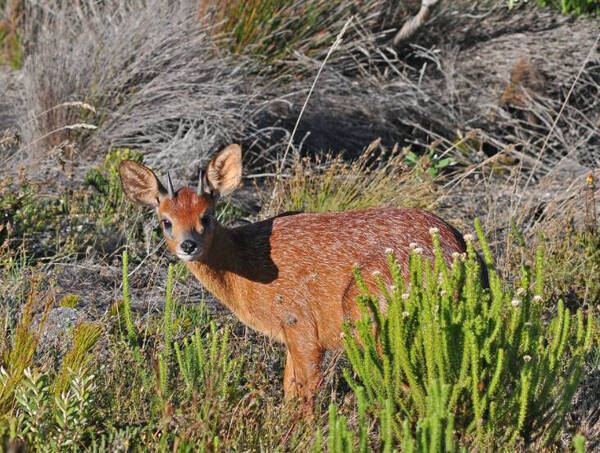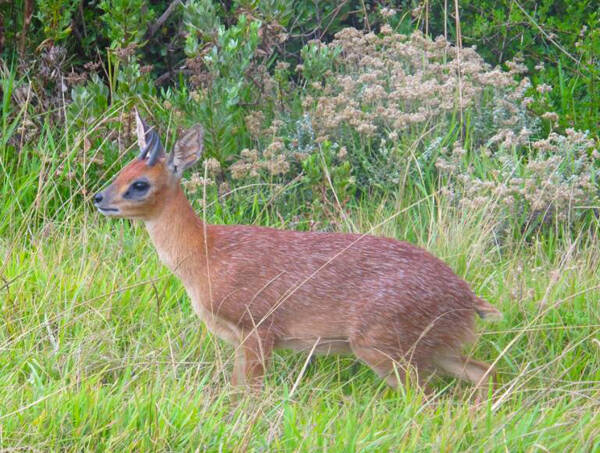Raphicerus melanotis
IUCN
LCBasic Information
Scientific classification
- name:Raphicerus melanotis
- Scientific Name:Raphicerus melanotis
- Outline:Ungulata
- Family:Artiodactyla Bovidae Stag
Vital signs
- length:Shoulder height 45-55 cm
- Weight:8-23kg
- lifetime:No verification information
Feature
Rather stocky, with large ears and white radial stripes on the inside
Distribution and Habitat
The Black-eared Steenbok is endemic to South Africa. It is found in a small range from Zululand to the Cape Province. It is mainly confined to the Cape region. They are still common in their historical range in the western and eastern Cape Provinces. But they are rarely seen in the northern Cape Province.
They prefer to forage in open grasslands, and hide in dense bushes during the day. Their range ranges from dry savannah to wet reedy areas. The native habitat is the "Fynbos Biome" (Cape Floristic Region), where they live in dense bushes. In the Cape Peninsula, they can be found on the edge of cities close to human activities. Sometimes wandering in orchards and vineyards, they also live in reed beds and river beds in the southern Karoo.
Appearance
The Black-eared Steenbok is very similar to the Lesser Steenbok and is a small antelope of very small size. The species is rather stocky, with a shoulder height of 45-55 cm and a weight between 8-23 kg. The straight pointed horns, 6.5-13 cm long, are found only in males, and the fur of males is also darker than that of females. The hide is composed of hard and wiry hair. Both adults and young have reddish-brown fur on the back, red underparts, and a reddish-yellow throat. White tips of hair from the nape to the upper half of the legs give these antelopes a grayish-white appearance. A dark Y-shaped mark can be seen running from the forehead down to the neck. The ears are large with white radial stripes on the inside. The lateral hooves are small, sometimes absent, and have small false hooves. Both the foot gland and the preorbital gland are present and well developed.
Details
Black-eared antelope (scientific name: Raphicerus melanotis) is also known as Cape Grysbok, with no subspecies.

Black-eared antelopes are territorial, and each animal has a clearly defined home. They mark nearby plants with scents from defecation, urination, and secretions from foot and preorbital glands. They are solitary animals and social during mating. They are mainly nocturnal, resting in the shade of bushes or rocks during the day and becoming active in the evening, looking for open areas to feed under the cover of darkness. When threatened, black-eared antelopes lie flat on the grass. If chased, these animals will run in a zigzag pattern and dive into a hole to avoid being preyed on. Crying only occurs when caught.
Scent marking is the main form of communication between black-eared antelopes. They have very well-developed preorbital glands that secrete a sticky black substance with a unique smell. However, as mammals, there are likely other forms of communication. Tactile communication occurs between mates, parents and offspring, and when opponents fight. Visual signals based on body posture may also be important.
Grapevine shoots are the preferred food of the black-eared antelope. They also consume grasses, fruits, shrubs, trees, and leaves. These antelopes are reported to be able to go for long periods without water, obtain most of their needs from food, and can survive for long periods without water.
Black-eared antelopes are monogamous or polygamous. No specific breeding season has been recorded. Mating can occur throughout the year, but the peak period is from September to December. Males are reported to fight violently for mates and cannot be kept together. The gestation period is 6 months, and each litter has one calf. Other details of reproduction and rearing have not been observed, but it is speculated that similar to the antelope calves, the calves will be hidden by their mothers for a period of time after birth, and they grow rapidly.

Black-eared fynbos are generally solitary and secretive in their behavior, so they are rarely seen. They are particularly difficult to see in dense vegetation, which is exacerbated in fire-prone areas such as the fynbos in the Western Cape (Castley and Lloyd, 2013). Estimates of population size are scarce, making it difficult to extrapolate data from individual studies or sites to discern the status of the population as a whole. Some studies are also relatively out of date and require updated data. For example, Scott (1991) studied the distribution of small antelopes in De Hoop Nature Reserve between 1985 and 1987 and recorded a density of 0.21 animals per 100 km for Black-eared Teal and 2.64 for Steenbok (Raphicerus campestris). Castley and Lloyd (2013) argue that such comparisons may not provide accurate estimates of population size given the relative lack of visibility and dense habitat preferences of Black-eared Teal populations. This again highlights the need for more reliable estimates of subpopulations at each site of Black-eared Teal distribution. However, all indications are that Black-eared Teal occur ‘freely’ in the landscape, on farmland, hunting grounds and vineyards within and outside the reserve.
Throughout its natural range in the Western Cape and Eastern Cape, the black-eared antelope is protected in protected areas. In the Western Cape, the black-eared antelope is found in approximately 9,104 km2 of protected areas, of which 5,451 km2 are provincial nature reserves, 1.8 km2 are local government nature reserves, and 2,319 km2 are national parks. Hunting is regulated through conservation legislation, with the aim of ensuring that the take-off is sustainable.
As of 2015, the black-eared antelope is found in protected areas: Table Mountain National Park, West Coast National Park, Agulhas National Park, Baviaanskloof and Groendal Nature Reserves, Addo Elephant National Park (AENP), but not in Namaka and Tankavakaroo National Parks. This is based on the mammal model made by the Cape Research Center in 2011 based on the assumed distribution map (Skinner and Chimimba 2005) and references.
Listed in the IUCN Red List of Threatened Species in 2016 ver 3.1 - Least Concern (LC).
Protect wildlife and eliminate bushmeat.
Maintaining ecological balance is everyone's responsibility!








